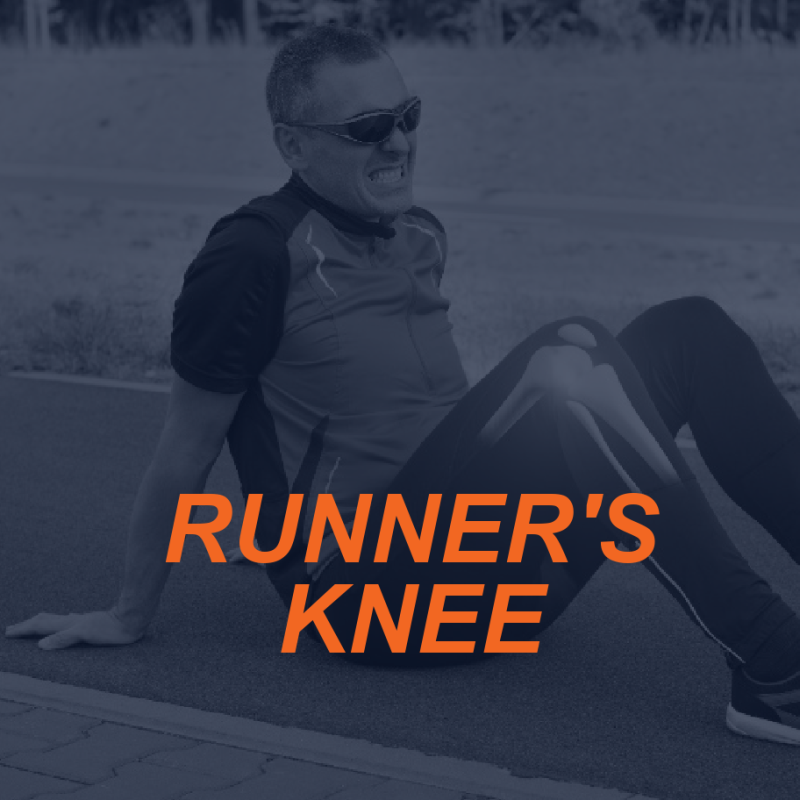
Runner’s knee is a broad term used to describe pain felt from various knee problems. Typically, it is used to refer to patellofemoral pain syndrome (PFPS), which is also a broad term used clinically to explain pain felt around the patella or on the front of the kneecap. Though the terms are broad, there are some specific factors that can contribute to this common injury and, contrary to its name, they aren’t limited to runners.
Common symptoms of runner’s knee
It isn’t uncommon for clients to speak of knee pain in various exercises. This doesn’t always suggest a serious injury– sometimes, addressing postural dysfunctions through assessments and improving form in squats or lunges can correct this discomfort – but we may consider the various symptoms of PFPS if knee pain persists.
Of course, as its name would suggest, the primary symptom of patellofemoral pain syndrome is pain. The pain associated with runner’s knee is generally dull, aching, and begins gradually. It typically presents during exercises that involve repeatedly bending the knee, like climbing stairs, running, jumping, and squatting.
Aside from exercise, people with PFPS may experience pain on the front of the knee when standing after sitting for a long period of time. In addition to pain, there may also be a popping or crackling sound when standing after prolonged sitting.
Risk factors
Runner’s knee can occur in anyone– not just runners– but it does occur more commonly in athletes and even more specifically in young adults and females.
Overuse from athletics or training, and specifically training that involves repeatedly bending the knee, is a significant factor contributing to knee pain. As with any injury, repeated stress can be injurious.
Additionally, sudden changes in activity– either frequency, duration, or intensity– can contribute to knee pain. For runners, this may look like drastically increasing mileage without building up to it.
Changes in footwear or playing surface– like young athletes switching from basketball season to soccer season or runners changing from the treadmill to the road– may also be a factor.
Another significant risk factor is the alignment of the kneecap. When there is poor tracking of the kneecap, there is a greater likelihood of injury. This often will indicate another risk factor which is muscular imbalance, especially in the quadriceps muscles as the quads help with patellar tracking.
Though less common, in some cases, chondromalacia patella is present. This is when there is a breakdown or softening of the cartilage beneath the kneecap. Pain in these cases is caused by inflammation of the synovium and the underlying bone, when the kneecap rubs against the thigh bone.
Prevention of Runner’s Pain
The term runner’s knee may contribute to the belief that running is inherently injurious and should be avoided. Our clients may express that they either cannot run or do not want to in order to “protect their knees.” Or, clients who are runners may have accepted the inevitability of knee pain.
While we can certainly honor our clients’ wishes and create programming that excludes running, we also have the opportunity to educate them on the truth about running. We can work to dispel the myth that running automatically leads to knee problems, and we can reassure our clients that smart programming can avoid painful outcomes.
Slowly progressing exercises, ensuring proper form, adequate footwear, and incorporating plenty of rest and recovery will all support our clients and potentially prevent injuries including PFPS.
Additionally, we may utilize assessments like the overhead squat assessment to uncover any muscle imbalances and then work to correct those imbalances. Because runner’s knee is often related to underdeveloped quads, we may focus on exercises that strengthen this muscle group.
Conclusion
Knee pain is common, but it isn’t inevitable. We can work with our clients to prevent knee pain by understanding some of the causes and we can look out for signs of a developing injury to suggest intervention before it becomes debilitating. Having a deeper understanding of common injuries is reassuring to our clients; we can strengthen our relationships with clients and improve their confidence in us when we understand their fears and concerns when we take intentional steps to prevent them from occurring.
References
https://www.webmd.com/pain-management/knee-pain/runners-knee
https://orthoinfo.aaos.org/en/diseases–conditions/patellofemoral-pain-syndrome/






